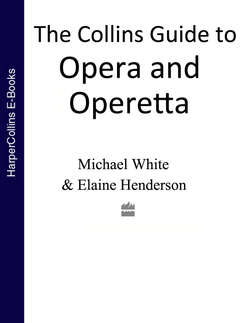Читать книгу The Collins Guide To Opera And Operetta - Michael White - Страница 16
ОглавлениеNorma
FORM: Opera in two acts; in Italian
COMPOSER: Vincenzo Bellini (1801–35)
LIBRETTO: Felice Romani; after Alexandre Soumet’s verse tragedy
FIRST PERFORMANCE: Milan, 26 December 1831
Principal Characters
Oroveso, chief of the druids and Norma’s father Bass
Pollione, Roman pro-consul in Gaul Tenor
Norma, high priestess of the druid temple Soprano
Adalgisa, young priestess of the temple Soprano
Clotilde, Norma’s confidante Mezzo-soprano
Flavio, Pollione’s friend Tenor
Synopsis of the Plot
Setting: Gaul; the Roman occupation
ACT I Oroveso comes to the sacred grove to pray to the gods to help him raise support to fight and defeat the Romans. After he has left, Pollione confides to Flavio that he no longer loves Norma, who has broken her vows of chastity for him and secretly borne his two children; he has transferred his affections to the young priestess, Adalgisa. When Adalgisa joins him, Pollione successfully persuades her to renounce her vows and go back to Rome with him. Adalgisa, in some distress, goes to see Norma to ask to be released from her vows. Norma, sympathising with her predicament, agrees to do so and asks the name of her lover. At that moment Pollione himself enters and Norma, stunned, realises the truth. She furiously denounces Pollione and the shocked Adalgisa declares that her first loyalty is to Norma, rejecting Pollione’s desperate attempts to persuade her to go with him.
ACT II In her hut Norma stands over her sleeping children, dagger in hand, contemplating the shame and humiliation they will suffer in the future because of her disgrace. She cannot bring herself to harm them, however, and suggests to Adalgisa that she should leave with Pollione and take the children with her to safety. Adalgisa’s response is to say that she will indeed go to Pollione – but only to try and convince him to return to Norma. In an atmosphere of gathering violence Norma learns that Pollione plans to abduct Adalgisa from the temple. Enraged, she strikes the great shield three times and declares war against Rome. Pollione is captured within the sacred temple but, to save his life, Norma offers herself, a disgraced and blasphemous priestess, as an alternative sacrifice. Confiding her children to Oroveso’s care, Norma prepares to mount the funeral pyre, as Pollione, overwhelmed by her selfless love and courage, commits himself to her once more and walks beside her to the flames.
Music and Background
Norma is Bellini’s masterpiece, written for what the composer called the ‘encylopaedic’ range of expression of the great bel canto singer Giuditta Pasta and closely responsive to the libretto of Felice Romani, which passed through many changes before the composer was satisfied with it. Norma herself is one of the most formidable roles in all opera, calling for extremes of tenderness and fury. Not for nothing does she get taken into the repertory of Wagner singers, and Wagner admitted a personal debt to Bellini’s combination of powerful passion with spacious melodies.
Highlights
Norma’s Act II ‘Casta diva’ is a benchmark aria for sopranos with the substance and finesse to tackle it (and there aren’t many of them). Also in Act II comes a superb scene for the two sopranos – ‘Mira o Norma’.
Did You Know?
The two great Normas of modern times once appeared in the opera together, in 1952. Maria Callas took the title role, Joan Sutherland the small part of Clotilde.
The 19th-century soprano, Therese Tietjens, playing Norma, swung her arm so wide as she struck the gong that she hit her leading man, who collapsed unconscious at her feet.
Recommended Recording
Joan Sutherland, Marilyn Horne, John Alexander, London Symphony Orchestra/Richard Bonynge. Decca 425 488-2. A classic from the 1960s, magnificently cast in the two soprano roles, with Sutherland in better voice than when she recorded Norma a second time, aged fìfty-eight(!).
